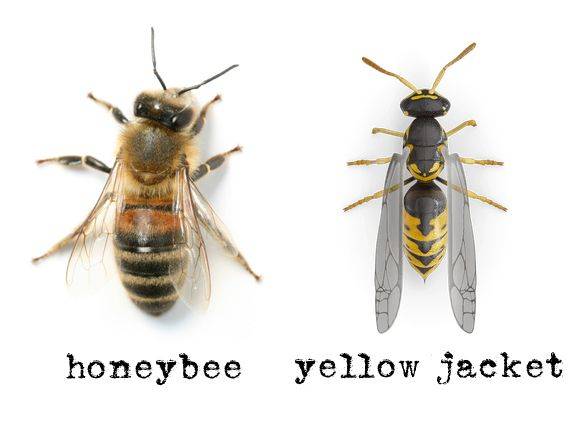If you’ve ever seen a black and yellow insect flying and wondered if it was a bee or a yellow jacket, you’re not alone. Many people often can’t tell the difference between the two, but to be honest, they can’t be any more different.
In fact, yellowjackets are wasps, not bees. They are known to be more aggressive, but what other differences are there and are they similar in any way? Please read carefully to find out.
Difference between Bees and Yellow jackets
Besides one being a wasp and the other a bee, there are other ways to tell them apart.
Looks
Bee and yellow jackets are both black and yellow. However, the yellow jacket is much lighter in color. Their yellow features are also shinier and easier to distinguish. Bees tend to be more amber.
Another feature unique to bees is hair. Bees are furry, with hair covering their chests, crowns, and legs. When they land on flowering plants, they use their hairs to collect pollen.

Yellow jackets are stylish, and they also have tight waists, which is the hallmark of the wasp. Bees look fatter and stronger.
Look at the antenna; the bee has a curved tip in the middle of its antennae. The yellow jacket has straight and black tentacles.
Colony and nesting
Both bees and yellow jackets are known to live in large colonies. A bee colony can easily accommodate up to 60,000 individuals. Yellow jacket nests can also hold thousands of insects.
Bee and yellow jacket colonies consist of queen bees, worker bees and drones. They actually have a lot in common in terms of their roles in the colony.
Queen bees lay their eggs, and the drone waits for the queen to mate with them. Workers take care of the nest, build new cells and gather resources.
Both queens are powerful; however, the yellow jacket queen is more independent than the bee. She can build her own colony without the help of workers or drones.
The yellow jacket queen collects wood fibers, which are then chewed to mix with saliva. After that, she will build a nest. Some yellow jackets nest in old underground caves, while others choose locations in or around houses.
The queen bee, on the other hand, is completely dependent on the help of worker bees. If a colony becomes overcrowded, the ruling queen will leave the lair with a group of workers.
She’ll find a safe place to rest as workers flock to protect her. Scout bees are looking for new nesting sites. Once they find the perfect location, they guide the queen to the new location.
This action is also called clustering. It was a way for the colony to control the population and a way for a new queen to emerge. Yellow Jackets aren’t known for coming in droves.
Diet
For the most part, the diets of bees and wasps are worlds apart. Bees feed on nectar and pollen, which they extract and collect from a variety of flowering plants. Bees have special mouthpieces to extract nectar.
Yellow jackets are known as picnic thieves. These wasps like to eat sugary drinks, fruit and meat. However, her favorite foods are flies and bees.
If you’re enjoying a refreshing drink outdoors in spring and summer, be sure to check before you sip it. You never know if yellow jacket has made it into your drink. Another thing yellow jackets have been known to do is get nectar from flowers.
Are they aggressive?
Both bees and wasps are known to be aggressive, but the reasons for their aggression are different. When bees feel threatened by themselves or the hive, they can become aggressive.
However, bees don’t like to sting. Only the female stings, but once it does, she dies. Her stinger is thorny, so she can’t pull it out again without hollowing herself out.
Wasps can become aggressive if disturbed. They attack and cause very painful stings. They can and will sting multiple times because their spines are smooth and can be easily removed after the sting.
Both bees and wasps inject venom when they sting. The venom causes immediate pain and redness.
However, neither bees nor yellow jacket drones have stingers, so they don’t sting.
Get rid of bees vs. yellow jackets
Unless you own an apiary, you probably aren’t interested in keeping bees in your yard. Worst-case scenario: Bees turn into swarms of wasps.
One of the most common ways to get rid of a bee colony is with the help of a beekeeper. Beekeepers usually bring a box with honeycombs.
Bees are attracted to the hive and fly around. The beekeeper then closes the box and the bees can be transported safely.
On the other hand, the yellow jackets require some more vigorous movements. If you suspect a wasp nest on your property, be sure to seek professional help. Because these wasps are extremely aggressive, it is important to remove the nest carefully.
You can call a pest controller and they will come to your home. Professionals inject a special insecticide into the opening where the wasp is found. The poison quickly kills any insects inside.
Yellow jackets and bees do share one predator – birds. There are some birds that occasionally eat bee or wasp food, especially in summer.
In summary
Bees are often confused with wasps and vice versa. However, now you know that there are many differences. The first change you might notice is the color, as the yellow jacket is lighter in color.
If you find bees in your garden, don’t use pesticides to kill them. They are important pollinators, so consult a professional if you don’t want them.
Yellow jackets are notorious for being very aggressive. They are so famous that several other flying species mimic their appearance to deter predators.

